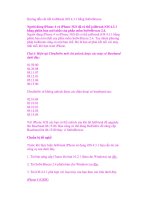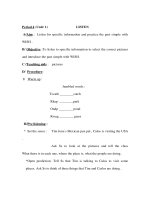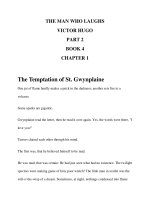4 3 1 leaves (poetry)
Bạn đang xem bản rút gọn của tài liệu. Xem và tải ngay bản đầy đủ của tài liệu tại đây (2.75 MB, 6 trang )
Reader
Genre
Poetry
Build Background
• Life Cycles of
Leaves
• Photosynthesis
• Seasons of the
Year
Access Content
Extend Language
•
•
•
•
•
• Word Origins:
Greek Roots
• Seasonal
Words
Labels
Caption
Definitions
Glossary
Rhyme
Scott Foresman Reading Street 4.3.1
ì<(sk$m)=bebjhf< +^-Ä-U-Ä-U
ISBN 0-328-14197-6
Talk About It
1. Why are leaves green in spring and summer?
2. What causes leaves to stop making food in
the fall?
Write About It
3. On a separate sheet of paper, make a timeline to
show what happens to leaves in spring, summer,
fall, and winter. Write about your favorite season,
and describe what is happening to leaves during
that season.
Spring
Summer
Fall
Winter
Extend Language
Another word for the fall season is autumn. In
many places, autumn is cool. Think of two words
to describe each season. For example, winter can
be snowy.
Illustration Credit: 3 Greg Harris.
Photographs
Every effort has been made to secure permission and provide appropriate credit for photographic material. The
publisher deeply regrets any omission and pledges to correct errors called to its attention in subsequent editions.
Cover ©Craig Tuttle/Corbis; 1 ©Peter Chadwick/DK Images; 2 ©Peter Chadwick/DK
Images; 4 ©David Roth/Getty Images; 5 ©Peter Chadwick/DK Images; 6 ©Craig Tuttle/
Corbis; 7 ©Craig Tuttle/Corbis.
ISBN: 0-328-14197-6
Copyright © Pearson Education, Inc.
All Rights Reserved. Printed in the United States of America.
This publication is protected by Copyright, and permission should be obtained from
the publisher prior to any prohibited reproduction, storage in a retrieval system,
or transmission in any form by any means, electronic, mechanical, photocopying,
recording, or likewise. For information regarding permission(s), write to: Permissions
Department, Scott Foresman, 1900 East Lake Avenue, Glenview, Illinois 60025.
Editorial Offices: Glenview, Illinois • Parsippany, New Jersey • New York, New York
1 2 3 4Sales
5 6 7Offices:
8 9 10 Needham,
V0G1 14 13
12 11 10 09 08Duluth,
07 06 05
Massachusetts•
Georgia • Glenview, Illinois
Coppell, Texas • Sacramento, California • Mesa, Arizona
osier leaf
A leaf is a wonder all
year round,
Up in a tree or down on
the ground.
Wide or narrow, shiny
or dull,
Shaped like a flame or
fan or star,
A leaf is a wonder all
year round,
Up in a tree or down on
the ground.
But maybe you’re curious—I am too—
You wonder what leaves are and what they do.
Well, look at a leaf, and you’ll be fascinated.
It’s one of the greatest things ever created.
It breathes for the tree and makes food too—
Hard to imagine? Well, it’s really true!
Leaves make sugary water that helps trees grow
Through photosynthesis. (What a word to know!)
It’s the process by which food is made
Inside the leaf, as this picture displays:
process: series of actions or events
What do you know about leaves on a tree?
You probably know a lot!
They give shade in summer and rustle in breezes.
They hide birds’ nests and feed hungry creatures.
You’ve probably seen a leaf that’s been eaten—
Chomp, chomp! Touch the holes and you feel
Where some caterpillars came for a meal.
And maybe you also know that in fall
Leaves lose their green. Gold shines through
Or red or orange or purple too.
A cool wind blows, and leaves flutter down—
Crunch, crunch! What a glorious sound!
Walk in them, roll in them, throw them around!
rustle: move with soft, crackling sound
flutter: move back and forth rapidly
2
Sugar
Carbon
Dioxide
Sun
Sunlight
Water
Water
Oxygen
In photosynthesis, the chlorophyll in the leaf gathers
energy from the sunlight. This energy helps water and
carbon dioxide combine to form the sugary water that
feeds the tree. Oxygen is also produced.
3
ginkgo leaf
A leaf is a wonder all
year round,
Up in a tree or down
on the ground.
Wide or narrow, shiny
or dull,
Shaped like a flame or
fan or star,
A leaf is a wonder all
year round,
Up in a tree or down
on the ground.
This all happens during long summer days,
The leaf gathers energy from the Sun’s rays.
Chlorophyll does this—it’s the substance in leaves
That gives them the rich green color you see.
The chlorophyll works with the strong sunlight
And carbon dioxide that’s in the air
And water that’s traveled up through the roots—
All these things combine in the leaf to produce
That sugary water that flows like juice—
It’s what the tree needs to grow all it grows:
Branches, buds, flowers, leaves, fruits, and seeds.
And one more thing happens that’s very good
The leaf makes oxygen when it makes food,
And that’s what people and animals breathe—
Just one more reason to care about trees!
In the fall, the trees shiver on cold mornings.
The sunlight turns golden, but it doesn’t last
Like it did in summer, when all day long
The leaves made food for the tree to grow
strong.
Without enough light, photosynthesis stops;
No more food will be made this year.
So the green color fades, and gold appears,
Or purple or orange or tan or red—
Turning the leaves into precious jewels.
You may be confused when I tell you this news,
But those colors were always there.
It’s just that the green was so strong before;
When the leaf made food for the tree,
It blocked out all those beautiful colors
That in the fall you can finally see.
Extend Language
Word Origins
The word photosynthesis means “putting together
with light” and comes from the Greek words phôs
(“light”) and syntithenai (“to put together”).
Can you tell why this is a good name for the process
by which leaves make food for trees?
substance: material
4
5
sweet gum
leaf
A leaf is a wonder all
year round,
Up in a tree or down
on the ground.
Wide or narrow,
shiny or dull,
Shaped like a flame
or fan or star,
A leaf is a wonder all
year round,
Up in a tree or down
on the ground.
In fall, the leaves glimmer, but little by little
They grow brown and their stems grow brittle.
The winter wind finally brings them all down
To serve as a blanket for the cold ground.
But new buds grow where the old stems were,
And all winter long, under frost and ice,
The new buds on branches stay closed tight.
And what goes on with the leaves that fell?
You wouldn’t believe it, but there’s lots to tell.
The leaves on the ground begin to decay
And turn into humus, a substance in soil
That is rich and good for new plants to grow,
When spring returns and warm winds blow.
glimmer: shine
In spring, the sun shines longer and longer.
Each day the light grows warmer and stronger.
The trees that were sleeping start to wake,
And the buds on their branches sprout and take
Light, warmth, and springtime showers
To unfold into fresh new leaves and flowers.
And here’s where it happens all over again—
When everything’s green, and tender, and new.
You know the story now; I leave it to you
To tell how leaves make food for trees
As they hide birds’ nests and sway in the breeze,
And give hungry creatures a tasty treat
And offer cool shade in the summer heat,
And fall in the fall in colorful glory—
Now it’s your turn. Can you tell the story?
brittle: fragile, likely to break
6
7
Glossary
car•bon di•ox•ide
, NOUN.
an odorless gas, present
in the atmosphere and
formed when any fuel
containing carbon is
burned. The air that
is breathed out of an
animal’s lungs contains
carbon dioxide. Plants
absorb it from the air
and use it to make
plant tissue.
chlo•ro•phyll
, NOUN. the
substance in green
plants that gives them
their color. Plants use
chlorophyll and light
to make their own
food from water and
carbon dioxide.
hu•mus
, NOUN. a dark
brown part of the soil
formed from decayed
leaves and other plant
matter. Humus contains
valuable plant foods.
Talk About It
ox•y•gen
, NOUN. an
invisible gas that forms
about one fifth of the
air and about one third
of water. Oxygen is
a chemical element.
Animals cannot live
without oxygen. Fire
will not burn without
oxygen.
pho•to•syn•the•sis
, NOUN.
the process by which
green plants use the
energy of light to
make their own food
from carbon dioxide
and water. During
photosynthesis, plants
send out oxygen.
1. Why are leaves green in spring and summer?
2. What causes leaves to stop making food in
the fall?
Write About It
3. On a separate sheet of paper, make a timeline to
show what happens to leaves in spring, summer,
fall, and winter. Write about your favorite season,
and describe what is happening to leaves during
that season.
Spring
Summer
Fall
Extend Language
Another word for the fall season is autumn. In
many places, autumn is cool. Think of two words
to describe each season. For example, winter can
be snowy.
Illustration Credit: 3 Greg Harris.
Photographs
Every effort has been made to secure permission and provide appropriate credit for photographic material. The
publisher deeply regrets any omission and pledges to correct errors called to its attention in subsequent editions.
Cover ©Craig Tuttle/Corbis; 1 ©Peter Chadwick/DK Images; 2 ©Peter Chadwick/DK
Images; 4 ©David Roth/Getty Images; 5 ©Peter Chadwick/DK Images; 6 ©Craig Tuttle/
Corbis; 7 ©Craig Tuttle/Corbis.
ISBN: 0-328-14197-6
Copyright © Pearson Education, Inc.
All Rights Reserved. Printed in the United States of America.
This publication is protected by Copyright, and permission should be obtained from
the publisher prior to any prohibited reproduction, storage in a retrieval system,
or transmission in any form by any means, electronic, mechanical, photocopying,
recording, or likewise. For information regarding permission(s), write to: Permissions
Department, Scott Foresman, 1900 East Lake Avenue, Glenview, Illinois 60025.
1 2 3 4 5 6 7 8 9 10 V0G1 14 13 12 11 10 09 08 07 06 05
8
Winter









